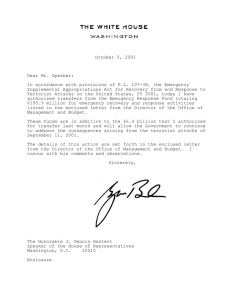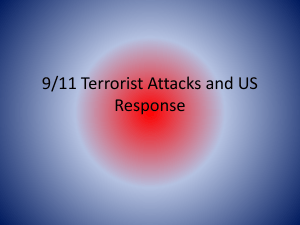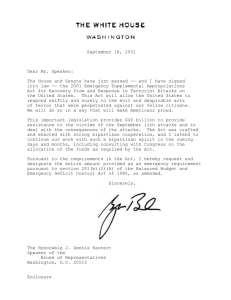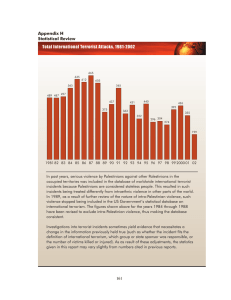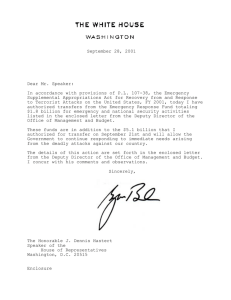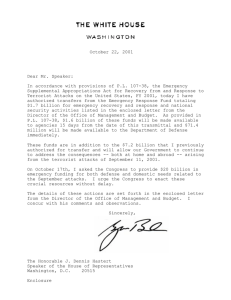An Individual’s Strategy for Responding to Chemical, Radiological, Nuclear, and
advertisement
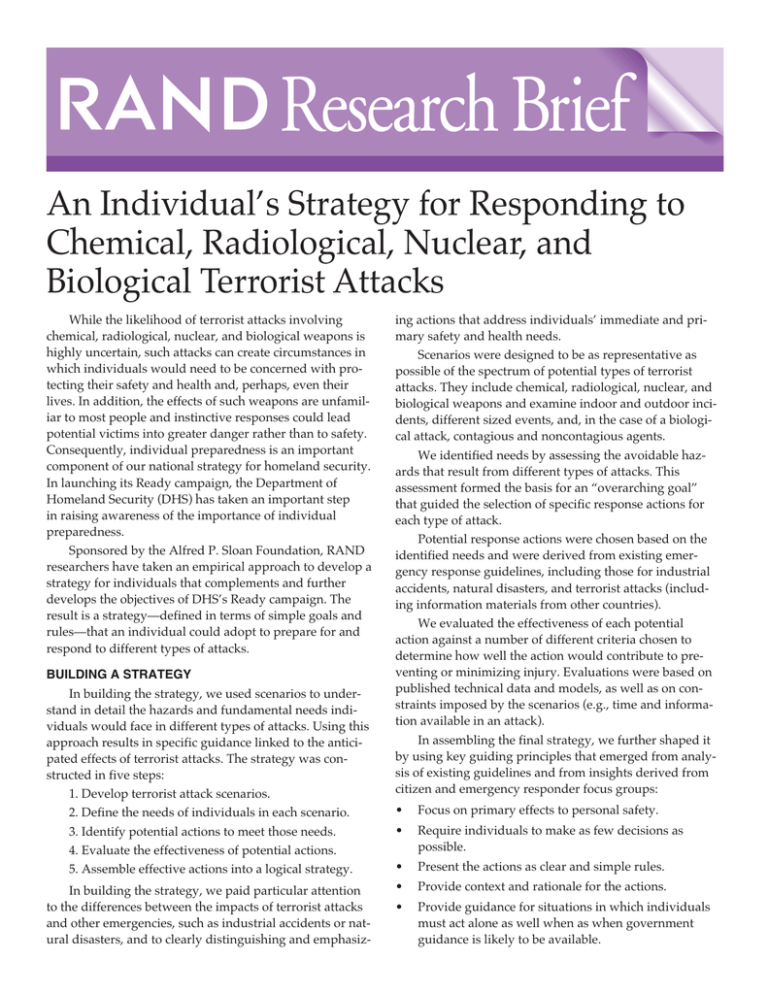
An Individual’s Strategy for Responding to Chemical, Radiological, Nuclear, and Biological Terrorist Attacks While the likelihood of terrorist attacks involving chemical, radiological, nuclear, and biological weapons is highly uncertain, such attacks can create circumstances in which individuals would need to be concerned with protecting their safety and health and, perhaps, even their lives. In addition, the effects of such weapons are unfamiliar to most people and instinctive responses could lead potential victims into greater danger rather than to safety. Consequently, individual preparedness is an important component of our national strategy for homeland security. In launching its Ready campaign, the Department of Homeland Security (DHS) has taken an important step in raising awareness of the importance of individual preparedness. Sponsored by the Alfred P. Sloan Foundation, RAND researchers have taken an empirical approach to develop a strategy for individuals that complements and further develops the objectives of DHS’s Ready campaign. The result is a strategy—defined in terms of simple goals and rules—that an individual could adopt to prepare for and respond to different types of attacks. BUILDING A STRATEGY In building the strategy, we used scenarios to understand in detail the hazards and fundamental needs individuals would face in different types of attacks. Using this approach results in specific guidance linked to the anticipated effects of terrorist attacks. The strategy was constructed in five steps: 1. Develop terrorist attack scenarios. 2. Define the needs of individuals in each scenario. 3. Identify potential actions to meet those needs. 4. Evaluate the effectiveness of potential actions. 5. Assemble effective actions into a logical strategy. In building the strategy, we paid particular attention to the differences between the impacts of terrorist attacks and other emergencies, such as industrial accidents or natural disasters, and to clearly distinguishing and emphasiz- ing actions that address individuals’ immediate and primary safety and health needs. Scenarios were designed to be as representative as possible of the spectrum of potential types of terrorist attacks. They include chemical, radiological, nuclear, and biological weapons and examine indoor and outdoor incidents, different sized events, and, in the case of a biological attack, contagious and noncontagious agents. We identified needs by assessing the avoidable hazards that result from different types of attacks. This assessment formed the basis for an “overarching goal” that guided the selection of specific response actions for each type of attack. Potential response actions were chosen based on the identified needs and were derived from existing emergency response guidelines, including those for industrial accidents, natural disasters, and terrorist attacks (including information materials from other countries). We evaluated the effectiveness of each potential action against a number of different criteria chosen to determine how well the action would contribute to preventing or minimizing injury. Evaluations were based on published technical data and models, as well as on constraints imposed by the scenarios (e.g., time and information available in an attack). In assembling the final strategy, we further shaped it by using key guiding principles that emerged from analysis of existing guidelines and from insights derived from citizen and emergency responder focus groups: • Focus on primary effects to personal safety. • Require individuals to make as few decisions as possible. • Present the actions as clear and simple rules. • Provide context and rationale for the actions. • Provide guidance for situations in which individuals must act alone as well when as when government guidance is likely to be available. Finally, we identified preparatory steps required to undertake the response actions. Preparatory Actions AN INDIVIDUAL’S STRATEGY The strategy for each type of attack consists of a description of the attack characteristics, the recommended response strategy, and essential preparatory actions. The attack characteristics summarize essential features of how the attack may occur, timelines, detection, and what guidance can be expected from government officials. The response actions begin with an overarching goal, then describe specific steps keyed to an individual's particular circumstances. Preparatory actions include only those steps necessary to respond to the different types of terrorist attacks. The boxes below summarize the strategy for a chemical attack. Note that the preparatory actions cover all attack types. The complete strategy covering chemical, Chemical Attack Characteristics Chemical attacks may use any of a variety of chemical warfare agents or industrial chemicals dispersed by sprayers or other means. Chemical agents affect people through inhalation or exposure to eyes and skin. Symptoms of chemical exposure include difficulty breathing, eye irritation, blurred vision, salivation, nausea, and convulsions. Chemical weapons act very quickly, often within a few seconds. As a result, government officials are unlikely to be able to give warning or guidance. Individuals must act almost instantly and on their own to minimize exposure. Chemical Attack Response Actions Overarching Goal: Find clean air very quickly. Response Actions 1. If attack is outdoors and you are outdoors, take shelter quickly in closest building, close all windows/doors, and shut off flow of air. If inside, stay inside. Then, to the extent possible, move upstairs, find interior room, and seal it.1 Remain inside until told it is safe to leave and then ventilate/vacate shelter immediately. 2. If attack is indoors, follow chemical attack plans specific to building. If plans are not available, open windows and breath fresh air. If windows are not accessible, evacuate (using escape hood if available2) by stairs to street or roof. 3. Once protected from exposure, decontaminate by removing clothing and showering. 4. When conditions are safe to move about freely, seek medical treatment.3 1. Gain understanding of what will be required to accomplish response actions in each type of terrorist attack: learn to recognize attack characteristics; understand the response actions. 2. Facilitate response actions by making plans and gathering information in advance: develop family communications plan; plan for longterm shelter; learn about appropriate kinds of medical treatment from medical professionals; discover building evacuation plans and potential shelters. 3. Ensure that general emergency kit accounts for terrorist attacks: dust mask, battery-powered radio, duct tape, and plastic sheeting. 4. Enhance protection through passive steps: weatherize home, install good-quality particulate filters. radiological, nuclear, and biological attacks is presented in the full report, available at www.rand.org/ publications/MR/MR1731 (see below). IMPLEMENTING THE STRATEGY This strategy is designed to be implemented by individual citizens to help them protect themselves in a terrorist attack. The ability of individuals to carry out the strategy can be improved by some enabling actions that governments and businesses can undertake. These include informing people about government emergency response plans, including medical treatments (e.g., vaccinations and antibiotics), decontamination steps, possible relocation plans, and how such information will be conveyed; providing education and training programs; installing detection and warning systems; and ensuring that products marketed for terrorism preparedness and response are safe and effective. While a terrorist attack is a horrific and chaotic event, this research identifies the essential needs individuals would face and provides simple actions to take to meet those needs. Following the recommended strategy can save lives, even in catastrophic terrorist attacks. 1Sealing a shelter in a chemical attack involves sealing windows, doors, vents, and other openings with duct tape and plastic sheeting or any other available materials. 2An emergency escape hood is a pullover respirator with an elastic neck seal that provides protection for only a short time. It should only be used when issued as part of a workplace or other organizational safety program and after proper training. 3Emergency officials will indicate when it is safe to move about freely. RAND research briefs summarize research that has been more fully documented elsewhere. This research brief describes work done within RAND Public Safety and Justice and documented in Individual Preparedness and Response to Chemical, Radiological, Nuclear, and Biological Terrorist Attacks, by Lynn E. Davis et al., MR-1731-SF, 2003, 198 pp., $28.00, ISBN: 0-8330-3473-1, and Individual Preparedness and Response to Chemical, Radiological, Nuclear, and Biological Terrorist Attacks: A Quick Guide, by Lynn E. Davis et al., MR-1731/1-SF, 2003, 30 pp., $15.00, ISBN: 0-8330-3487-1, available from RAND Distribution Services (Telephone: 310-451-7002; toll free 877-584-8642; FAX: 310-451-6915; or email: order@rand.org). Abstracts of RAND documents may be viewed at www.rand.org. Publications are distributed to the trade by NBN. RAND® is a registered trademark. RAND is a nonprofit institution that helps improve policy and decisionmaking through research and analysis; its publications do not necessarily reflect the opinions or policies of its research sponsors. R 1700 Main Street, P.O. Box 2138, Santa Monica, California 90407-2138 • Telephone 310-393-0411 • FAX 310-393-4818 1200 South Hayes Street, Arlington, Virginia 22202-5050 • Telephone 703-413-1100 • FAX 703-413-8111 201 North Craig Street, Suite 202, Pittsburgh, Pennsylvania 15213-1516 • Telephone 412-683-2300 • FAX 412-683-2800 www.rand.org RB-6014-SF (2003)

